
The Cambs
at War
Who Were
The Cambs
1/1st Btn 1914-1919
1914 - 1/1st Overview
1915 - 1/1st Overview
1915 - St Eloi
1915 - Fosse Wood
1916 - 1/1st Overview
1916 - The Schwaben
1916 - St Pierre Divion
1917 - 1/1st Overview
1917 - St Julien
Insignia, Medals & Books
Remembering The Cambs
Biographies
About Us &
This Site
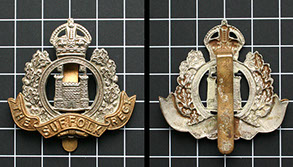
Fig. A
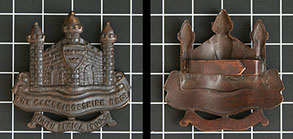
Fig. B
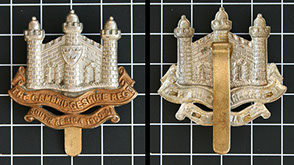
Fig. C
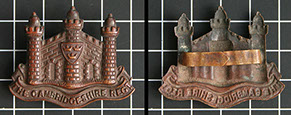
Fig. D
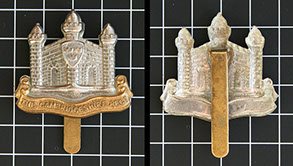
Fig. E
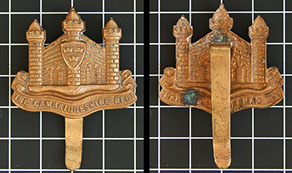
Fig. F
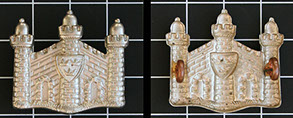
Fig. G
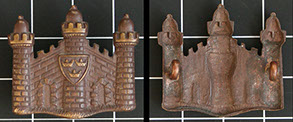
Fig. H
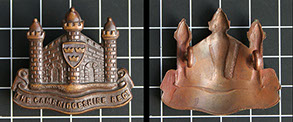
Fig. I

Fig. J
Fig. K

Fig. L
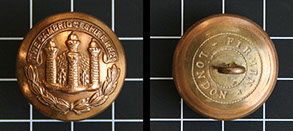
Fig. M
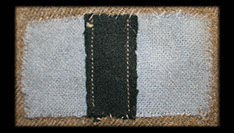
Fig. N
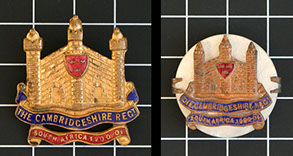
Fig. O
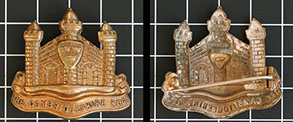
Fig. P
Badges and Insignia
The examples and information on this page are some of the main items of insignia worn by the Cambs TF. Other badges, variations, and versions will be added over time. If you need help identifying a badge that is not shown please email us at the address below.
Cap Badges
Suffolk Regiment TF Cap Badge
In the months following the creation of the Cambs the new insignia of the Regiment was still being designed. During this time both officers and men wore the insignia of the Territorial Force units of the Suffolk Regiment. The other ranks version (Fig. A) consists of a bi-metal badge with a two towered castle, representing the castle at Bury St Edmunds, surrounded by a wreath of oak leaves above which is a crown, all of this is in white metal. Bellow the wreath is a gilding metal scroll with the words "The Suffolk Regt.". The fitting for the badge consisted of a long vertical slider mounted on the back of the crown.
The officer's version came in both a bronzed finish or a high quality silver/silver plate. Early photos of the Cambs show some officers continued to wear Suffolk Regt insignia for several years after the introduction of the Cambs badges. Pictures from the 1909 summer camp also show certain Coys all wearing Suffolk TF badges still where other Coys all had Cambs badges by this point. By the annual camp of 1910 all men, apart from a small handful of officers, were wearing the 1909 pattern of Cambs Regt badge.
1909 Cap Badge
When the Cambridgeshire Regiment TF was formed in 1909 a new badge was sealed. It comprised of a stylised fortified bridge, representing both Cambridge castle and the city's position on the river Cam. In the centre of the badge is a shield bearing the arms of Ely. Beneath this are two scrolls, written in the first is "The Cambridgeshire Regt." and in the second smaller scroll "South Africa 1900-1901". This South Africa scroll was worn as a battle honour due to the volunteers of the 3rd Cambs VBs that fought in the Boer War with the Suffolk Regiment.
This badge came in a bronzed finish for officers (Fig. B) and a bi-metal version (Fig. C), with the main part of badge in white metal and scrolls in gilding metal, for other ranks . The officer's bronzed badge was fixed to the cap by two prongs that would be bent round once they had pierced through the material of the cap. This was the standard method of fixing bronzed officers badges as they were not meant to be removed for polishing. Other ranks cap badges were all fitted with a long vertical "slider" to the back which would be pushed through a small slit in the material of the cap. This fitting enabled the soldier to remove the badge easily for polishing and cleaning.
1914 Cap Badge
At the start of 1914 Territorial Force regiments, including the Cambs, had badges that carried the additional South Africa battle honour scroll. In order to reduce cost, speed up production and keep up with the mass surge in recruiting (and possibly as a distinction for the earlier volunteers who kept their old badges) new versions were quickly produced without the scroll. These were issued once stocks of the old badges ran out. For the Cambs these first start to appear in pictures taken at the annual camp in July 1914. Like the previous version they were made with a bronzed finish for officers (Fig. D) and a bi-metal version for other ranks (Fig. E). This version of the badge remained as the standard cap badge for the Cambs until October 1952.
1916 Economy Cap Badge
As a further attempt at saving both money and time economy versions of numerous regiment and corps badges were authorised in 1916. The other ranks bi-metal Cambs badge was replaced with an all gilding metal version (Fig. F). As with the previous versions the fitting was in the form of a long slider to the back. This economy version was quickly phased out after the war.
Collar Badges
These followed the same design as the cap badge consisting of the fortified bridge with the shield in the centre, it did not however have the scrolls below. This collar design remained in use until after the Second World War. During the Territorial Force era examples were worn by other ranks in white metal (Fig. G) on their scarlet "walking out" dress but were not worn on their khaki service dress (this came into practice after WW1). Officers wore a higher quality silver version on their scarlet dress and a bronzed version (Fig. H) on their service dress. Fittings for all versions are in the form of two metal lugs brazed to the reverse. These lugs were pushed through holes made in the collar and a metal cotter pin was then pushed through the loop in the lugs.
Officers also wore a small separate metal "T" below the collar badge, fitted in the same way, this denoted that the officer was part of the TF. There are also several photographs dating from early in the war that show some officers wearing scrolled versions of the collar badge, identical to the 1909 and 1914 cap badge. Examples of these are identifiable from cap badges dues to the fixing being short lugs instead of prongs (Fig. I).
Shoulder Titles
Other ranks wore the word "Cambridgeshire" in an arc on each shoulder (Fig J). Made in gilding metal for the khaki service dress and in white metal for the scarlet "walking out" dress. It was fixed to the epaulettes of the uniform by two metal lugs mounted to the reverse. These lugs were pushed through two small holes made in the epaulette, once through a metal cotter pin was pushed through the loop in the lugs pinning the badge in place. Mounted separately in the centre of the arc was a gilding metal "T", fixed the same way as the arc, this denoted that the soldier was a Territorial.
There are numerous photographs of Cambs soldiers mostly dating from mid 1915-1916 that show these shoulder titles complete with the "T" being worn incorrectly on collars instead of epaulettes.
Late in the war a new version of Cambs shoulder title started to be introduced, this consisted of the word "Cambridge" in a shallower arc with the metal "T" now fixed in the middle above the lettering (Fig. K). After the war this version replaced the earlier "Cambridgeshire" shoulder title and remained in use for many years until it was replaced by a cloth shoulder title during the Second World War.
The Imperial Service Badge
This badge (Fig. L) is often seen in photos dating from the outbreak of war through to 1915. It denoted that the the Territorial Force soldier had signed up for overseas service and waived his right to stay in the UK. It was worn on the right breast of the uniform by both officers and other ranks. It was fixed to the uniform by a strong pin mounted to the back and was normally made in cupro-nickel but examples also exists made in brass.
The badge was normally removed by soldiers of the 1/1st Battalion when they arrived in France. However it does still appear in later photos of the early volunteers who were posted to the UK based battalions despite having volunteered for overseas service.
Regimental Buttons
As part of their service dress uniform officers wore domed metal buttons made in brass and often with a gilt finish (Fig. M). Made in two sizes for the tunic. The design on the button consisted of a scroll at the top following the curve, written inside this was "The Cambridgeshire Regt". In the middle of the badge was the fortified bridge and shield of the cap badge and below this mirroring the scroll was a half wreath of laurels.
Battle Patch
In June 1917 the 1/1st Battalion began wearing a battalion identification badge on both arms. This was a large Cambridge Blue cloth square with a vertical black stripe down the middle. The blue represented Cambridge and the black stripe was in honour of the CO, Riddell, as it represented his Rifle Brigade connection. It was a sign of respect and affection although it was jokingly referred to by at least one officer as "the bar sinister".
In early 1918 the battle patch changed size and shape. It was made into a narrower rectangle and the black stripe became wider (Fig, N).
Sweetheart Badges
Sweetheart badges became fashionable during the Boer War but with the outbreak of the First World War and the mass waves of enlistment their popularity soared. These small items of jewellery, normally in the form of a pin or brooch, were given by soldiers and sailors to their loved ones. They are normally found in the style of miniature versions of the various regimental badges and emblems (Fig. O). Quality and materials vary hugely from very simply and crudely made pieces through to exquisite gold and enamel items made by some of the finest jewellers of the day. It is not unusual to find modified cap badges (Fig. P) and buttons that have had their fittings removed and replaced with a brooch pin so as they could be worn by a loved one or family member as jewellery.

This site went live on the 14th February 2015 to mark 100 years since the 1/1st Cambs went off to war.
WE WILL REMEMBER THEM
Email us: cambsregt@gmail.com
Copyright 2015, 2016, 2017, 2018, 2019 by Felix Jackson. The information and images on this site should not be reproduced without prior permission.